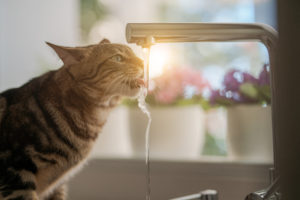Raleigh Durham North Carolina Water Conditions
Frequently Asked Questions

Where does my drinking water come from?
The United States has one of the safest and most reliable drinking water systems in the world. Every year, millions of people living in the United States get their tap water from a public community water system.
The drinking water that is supplied to our homes comes from either a surface water or ground water source. Surface water collects in streams, rivers, lakes, and reservoirs. Ground water is water located below the ground where it collects in pores and spaces within rocks and in underground aquifers. We get ground water by drilling wells and pumping it to the surface.
Water travels to your tap from a surface water or ground water source through your local water utility or through an individual water system, such as a private well.
A private well uses ground water as its water source. Owners of private wells and other individual water systems are responsible for ensuring that their water is safe from contaminants.
How is my drinking water regulated?
All public water systems in the United States are required to follow the standards and regulations set by the U.S. EPA. EPA regulations that protect public water systems do not apply to privately owned wells or other individual water systems. Owners of private wells are responsible for ensuring that their well water is safe from contaminants.

What type of health issues can be related to water quality?
Contaminants in our water can lead to health issues, including gastrointestinal illness, reproductive problems, and neurological disorders. Infants, young children, pregnant women, the elderly, and people with weakened immune systems may be at increased risk for becoming sick after drinking contaminated water. For example, elevated levels of lead can cause serious health problems, especially for pregnant women and young children. Federal law requires that systems reduce certain contaminants to set levels to protect human health.
How do I know that the water in my home is safe to drink?
EPA is responsible for making sure that public water supplies within the United States are safe. In 1974, Congress passed the Safe Drinking Water Act. This law sought to protect the nation’s public drinking water supply by giving EPA authority to set the standards for drinking water quality and oversee the states, localities, and water suppliers who implement those standards. In 1986 and 1996, the law was amended to protect drinking water and its sources, which include rivers, lakes, reservoirs, springs, and ground water wells.
How do germs and chemicals get into my drinking water?
There can be many sources of contamination of our water systems. The most common sources of contaminants include:
- Naturally occurring chemicals and minerals (e.g., arsenic, radon, uranium)
- Local land use practices (e.g., fertilizers, pesticides, livestock, concentrated animal feeding operations)
- Manufacturing processes
- Sewer overflows
- Malfunctioning wastewater treatment systems (e.g., nearby septic systems)
EPA regulates many contaminants that pose known human health risks. EPA makes sure that water meets certain standards, so you can be sure that high levels of contaminants are not in your water.
How do I filter water at my home if I am concerned about water quality?
Different water filters have different functions. Some can make your water taste better, while others can remove harmful chemicals or germs.
How do I remove the parasite Cryptosporidium from my drinking water?
The parasite Cryptosporidium can survive a long time, even after the water is treated with chlorine or iodine. Cryptosporidium can be removed from water by filtering through a reverse osmosis filter, an “absolute one micron” filter, or a filter under NSF International Standard #53 for either “cyst removal” or “cyst reduction.” Filtering does not remove bacteria and viruses. Ultraviolet light treatment and ozone treatment of water are effective against Cryptosporidium at properly maintained levels.
I found bluish-green stains in my toilet’s holding tank. What does that mean?
This is a sign of acidic water. ADD MORE HERE
How can I find out if there has been a violation in our public water standard?
When water quality standards have not been met, your public water system must alert and notify customers if there is a risk to their health. Your annual Consumer Confidence Report is another way to find out about the water quality in your area, and find information regarding contaminants, possible health effects, and the water’s source.
Who do I need to contact to find out more information about water quality in my area?
Every community water supplier must provide an annual report to its customers known as the Consumer Confidence Report. The report provides information on your local drinking water quality, including the water’s source, contaminants found in the water, and how consumers can get involved in protecting drinking water.
How often does the local public water system test my drinking water?
Frequency of drinking water testing depends on the number of people served, the type of water source, and types of contaminants. Certain contaminants are tested more frequently than others, as established by the Safe Drinking Water Act. You can find out about levels of regulated contaminants in your treated water for the previous calendar year in your annual Consumer Confidence Report.
What common contaminants are included in this testing?
EPA sets standards and regulations for the presence and amount of over 90 different contaminants in public drinking water, including E.coli, Salmonella, and Cryptosporidium species.
What should I do if I want my household water tested?
The United States has one of the safest public water supplies in the world. However, if you are concerned about contaminants in your home’s water system contact Clear Choice Water Solutions for a FREE water test kit.
If there is a boil water advisory in my community, how do I disinfect my drinking water?
To disinfect your drinking water during a boil water advisory, you should boil your water at a rolling boil for at least 1 minute (at elevations above 6,500 feet, boil water for 3 minutes). Boiling your water for at least 1 minute at a rolling boil will kill all harmful bacteria, parasites, and viruses from drinking water. You can also treat small volumes of drinking water by using a chemical disinfectant, such as unscented household chlorine bleach or by using a water filter.
What are the main types of ground water wells?
According to EPA, there are three basic types of drinking wells: dug, drilled, and driven. Proper well construction and continued maintenance are critical to the safety of your water supply. It is important to know what type of well you have. Well type affects how likely your water is to become contaminated and what kind of maintenance procedures you should follow. You may be able to determine the type of well you have by looking at the outer casing and cover of the well.
As a private well owner, should I have my well tested?
Yes, as a private well owner, you are responsible for testing your well to ensure the water is safe to drink. EPA is responsible for making sure that the public water supply within the United States is safe. However, EPA does not monitor or treat private well drinking water. For information on testing your well water, request our FREE well water testing kit.
When should I have my well tested?
You should have your well tested once a year for total coliform bacteria, nitrates, total dissolved solids, and pH levels. If you suspect other contaminants, you should test for those as well. You should also have your well tested if:
- There are known problems with well water in your area.
- You have experienced problems near your well (e.g., flooding, land disturbances, and nearby waste disposal sites).
- You replace or repair any part of your well system.
- You notice a change in water quality (e.g., taste, color, odor).
Edited comments from material provided by: US Environmental Protection Agency https://www.cdc.gov/
